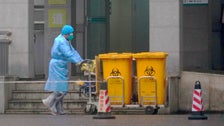
BEIJING (Reuters) – China put on lockdown on Thursday two cities at the epicenter of a new coronavirus outbreak that has killed 17 people and infected nearly 600, as health authorities around the world scramble to prevent a global pandemic.
Health officials fear the transmission rate will accelerate as hundreds of millions of Chinese travel at home and abroad during week-long holidays for the Lunar New Year, which begins on Saturday.
The previously unknown virus strain is believed to have emerged late last year from illegally traded wildlife at an animal market in the central Chinese city of Wuhan.
Most transport in Wuhan, a city of 11 million people, was suspended on Thursday morning and people were told not to leave. Hours later, state media in neighboring Huanggang, a city of some 6 million people, said it was imposing a similar lockdown.
Chinese authorities gave no new details on the numbers of virus infections but it has been reported in Beijing, Shanghai and Hong Kong, and several other countries including the United States, stoking fears it is already spreading worldwide.
Wuhan’s city government said it would shut down all urban transport networks and suspend outgoing flights from 10 a.m. (0200 GMT). Domestic media said some airlines were operating after the deadline, however.
State media broadcast images of one of Wuhan’s transport hubs, the Hankou rail station, nearly deserted, with gates blocked or barred. The government is urging citizens not to leave the city.
State media reported highway toll booths around Wuhan were closing down, which would effectively cut off road exits. Guards were patrolling major highways, one resident told Reuters.
As the city slipped into isolation, residents thronged into hospitals for checks and scrambled for supplies, clearing out supermarket shelves and queuing for petrol.
Authorities in Huanggang ordered indoor entertainment venues including cinemas and internet cafes to close and were asking citizens not to leave other than under special circumstances, state media said.
Authorities had confirmed 571 cases and 17 deaths by the end of Wednesday, China’s National Health Commission said. Earlier, it said another 393 suspected cases had been reported.
Of eight known cases worldwide, Thailand has confirmed four, while Japan, South Korea, Taiwan and the United States have reported one each.
In a report on Wednesday, Imperial College London said it estimated a total of 4,000 cases of the coronavirus in Wuhan alone as of Jan. 18, an infection rate based on the number of cases reported in China and elsewhere.
VIRUS SPREADING
In contrast with its secrecy over the 2002-03 Severe Acute Respiratory Syndrome (SARS) that killed nearly 800 people, China’s communist government has provided regular updates to avoid panic ahead of the holidays.
During a visit to Wuhan, Vice Premier Sun Chunlan said authorities needed to be open about the virus and efforts to contain it, the official Xinhua news agency said.
The World Health Organization (WHO) has said it will decide on Thursday whether to declare the outbreak a global health emergency, which would step up the international response.
If it does so, it will be the sixth international public health emergency to be declared in the last decade.
Some experts believe the new virus is not as dangerous as previous coronaviruses such as SARS and Middle East Respiratory Syndrome (MERS), which has killed more than 700 people since 2012.
“The early evidence at this stage would suggest it’s not as severe,” Australia’s Chief Medical Officer Brendan Murphy told reporters.
WHO Director-General Tedros Adhanom Ghebreyesus told reporters in Geneva that China’s actions were “very strong” but called on it to take “more and significant measures to limit or minimize the international spread”.
“We stressed to them that by having a strong action not only they will control the outbreak in their country but they will also minimize the chances of this outbreak spreading internationally. So they recognize that,” he said.
Despite China’s response, stock markets across Asia were on the back foot on Thursday, led by drops of roughly 1.5% in Hong Kong and Shanghai while China’s yuan fell to a two-week low.
FLIGHTS, RAIL SUSPENDED
There is no vaccine for the virus, which can spread through respiratory transmission. Symptoms include fever, difficulty in breathing and cough, similar to many other respiratory illnesses.
Preliminary research suggested the virus was passed on to humans from snakes, but government medical adviser Zhong Nanshan has also identified badgers and rats as possible sources. Confirmed sufferers include 15 medical workers.
Many Chinese were cancelling trips, buying face masks and avoiding cinemas and shopping centers, and even turning to an online plague simulation game as a way to cope.
The release of seven movies over the Lunar New Year has been postponed. The holiday is the high season for distributors and cinemas attract huge crowds.
Airports globally stepped up screening of passengers from China and the European Centre for Disease Control and Prevention said the further global spread of the virus was likely.
“Obviously this is a huge concern for the world,” Britain’s business minister, Andrea Leadsom, told Sky.
(Reporting by Yawen Chen, Se Young Lee and Sophie Yu in Beijing, Sam Shen and Engen Tham in Shanghai, Ben Blanchard in Taiwan, Alison Lui and Donny Kwok in Hong Kong, John Geddie and Aradhana Aravindan in Singapore, Stephanie Ulmer-Nebehay in Geneva, Kate Kelland and Elizabeth Howcroft in London; Writing by Michael Perry; Editing by Stephen Coates and Clarence Fernandez)
Calling all HuffPost superfans!
Sign up for membership to become a founding member and help shape HuffPost’s next chapter
Credit: Source link